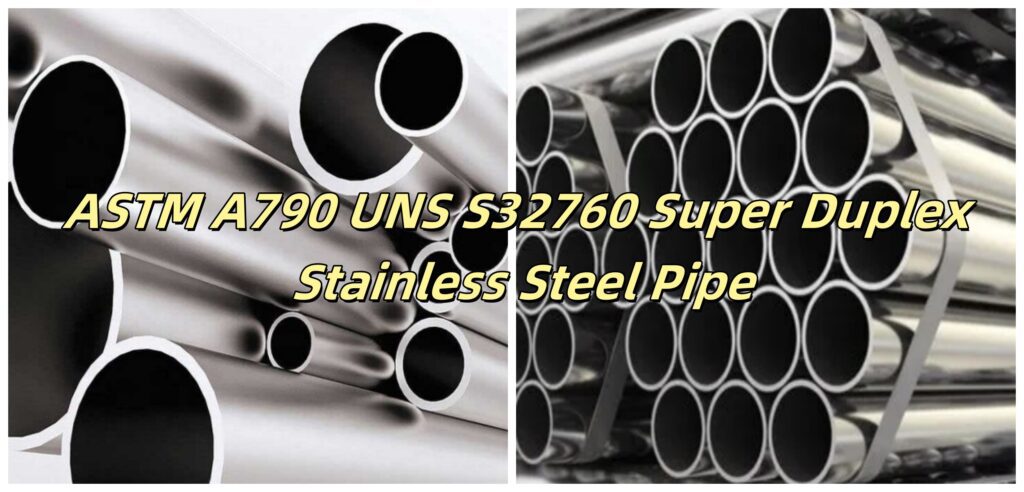ASTM A790 UNS S32760 Super Duplex Stainless Steel Pipe is a material that excels in extreme corrosion and high-strength applications. It belongs to the Super Duplex Stainless Steel family, combining the advantages of austenitic and ferritic stainless steels, and further improves performance through higher chromium, molybdenum and nitrogen contents.
UNS S32760 Super Duplex Stainless Steel Pipe is a highly sought-after material in various industries due to its excellent corrosion resistance.
S32760 Duplex Steel has strong strength and corrosion resistance. This type of stainless steel pipe is often used in applications such as oil pipelines, boiler tubes and heat exchangers, where corrosion resistance is critical to the life and performance of the equipment. It has strong resistance to chloride corrosion, high thermal conductivity and low thermal expansion coefficient. The high chromium, molybdenum and nitrogen content makes it highly resistant to pitting, crevice corrosion and other corrosion.

ASTM A790 UNS S32760 Pipe Specification
| Processing Method | Seamless and Welded |
| Size Range | 1/8” – 30” / DN6 – 750 |
| Thickness Schedule | SCH10 SCH20 STD SCH40 SCH60 SCH80 SCHXS SCH100 SCH120 SCH140 SCH160 SCHXXS |
| Length | 6m or 12 m or Random |
| Standard | ASME B36.19,ASTM A789, ASTM A790, ASTM A928, ASME SA789, |
| Surface Treatment | Polish , Mirror , Epoxy Powder FBE, 2PE, 3PE Coating |
| Material Grade | ASTM A790 S32205, S31803, 32750, 32760, S32550 |
| Pipes Ends | Plain Ends / Beveled Ends |
ASTM A790 Pipe Standard
This specification covers seamless and straight-seam welded ferritic/austenitic steel pipe intended for general corrosive service, with particular emphasis on resistance to stress corrosion cracking. These steels are susceptible to embrittlement if used for prolonged periods at elevated temperatures.
Appendix X1 of this specification lists the dimensions of welded and seamless stainless steel pipe as shown in ANSI B36.19. Pipe having other dimensions may be furnished provided such pipe complies with all other requirements of this specification.
Appendix X1
| Stainless Steel Pipe (ASME B 36.19M) | ||||||||||
| Nominal Size | OD | Sch5s | Sch10s | Sch40s | Sch80s | |||||
| DN | NPS | 0 | T | kg/m | T | kg/m | T | kg/m | T | kg/m |
| 6 | 1/8 | 10.3 | 1.24 | 0.28 | 1.73 | 0.37 | 2.41 | 0.47 | ||
| 8 | 1/4 | 13.7 | 1.65 | 0.49 | 2.24 | 0.63 | 3.02 | 0.8 | ||
| 10 | 3/8 | 17.1 | 1.65 | 0.63 | 2.31 | 0.84 | 3.2 | 1.1 | ||
| 15 | 1/2 | 21.3 | 1.65 | 0.82 | 2.11 | 1 | 2.77 | 1.27 | 3.73 | 1.62 |
| 20 | 3/4 | 26.7 | 1.65 | 1.04 | 2.11 | 1.28 | 2.87 | 1.69 | 3.91 | 2.2 |
| 25 | 1 | 33.4 | 1.65 | 1.33 | 2.77 | 2.09 | 3.38 | 2.5 | 4.55 | 3.24 |
| 32 | 1 1/4 | 42.2 | 1.65 | 1.68 | 2.77 | 2.7 | 3.56 | 3.39 | 4.85 | 4.47 |
| 40 | 1 1/2 | 48.3 | 1.65 | 1.95 | 2.77 | 3.11 | 3.68 | 4.05 | 5.08 | 5.41 |
| 50 | 2 | 60.3 | 1.65 | 2.44 | 2.77 | 3.93 | 3.91 | 5.44 | 5.54 | 7.48 |
| 65 | 2 1/2 | 73.0 | 2.11 | 3.77 | 3.05 | 5.26 | 5.16 | 8.63 | 7.01 | 11.41 |
| 80 | 3 | 88.9 | 2.11 | 4.6 | 3.05 | 6.45 | 5.49 | 11.29 | 7.62 | 15.27 |
| 90 | 31/2 | 101.6 | 2.11 | 5.29 | 3.05 | 7.4 | 5.74 | 13.57 | 8.08 | 18.63 |
| 100 | 4 | 114.3 | 2.11 | 5.96 | 3.05 | 8.36 | 6.02 | 16.07 | 8.56 | 22.32 |
| 125 | 5 | 141.3 | 2.77 | 9.67 | 3.4 | 11.57 | 6.55 | 21.77 | 9.53 | 30.97 |
| 150 | 6 | 168.3 | 2.77 | 11.55 | 3.4 | 13.48 | 7.11 | 28.26 | 10.97 | 42.56 |
| 200 | 8 | 219.1 | 2.77 | 15.09 | 3.76 | 19.96 | 8.18 | 42.55 | 12.7 | 64.64 |
| 250 | 10 | 273.1 | 3.4 | 23.08 | 4.19 | 27.78 | 9.27 | 60.31 | 12.7 | 96.01 |
| 300 | 12 | 323.9 | 3.96 | 31.89 | 4.57 | 36 | 9.53 | 73.88 | 12.7 | 132.08 |
| 350 | 14 | 355.6 | 3.96 | 35.06 | 4.78 | 41.3 | ||||
| 400 | 16 | 406.4 | 4.19 | 42.41 | 4.78 | 47.29 | ||||
| 450 | 18 | 457.2 | 4.19 | 47.77 | 4.78 | 53.26 | ||||
Super Duplex Stainless Steel Pipe Excellent performance advantages
1. Excellent resistance to stress corrosion cracking (SCC): Shows excellent resistance to SCC in chloride and hydrogen sulfide (acidic) environments, which is a weakness of many austenitic stainless steels (such as 316L).
2. Good acid corrosion resistance: High corrosion resistance to a variety of organic and inorganic acids (including hydrochloric acid and sulfuric acid).
3. Resistance to erosion corrosion and corrosion fatigue: Suitable for use in environments where wear and corrosion coexist.
4. Very high yield strength (usually twice that of 316L stainless steel), which allows for reduced wall thickness in design, thereby reducing material cost and weight.
5. Good toughness: Despite its high strength, it still maintains good toughness, including impact toughness at sub-zero temperatures (down to -46°C).
6. Good weldability: Despite being a high-alloy steel, it still has good weldability under appropriate welding processes.
Super Duplex Steel UNS S32760 Pipe Chemical Composition
| CHEMICAL | LIMITS | C | Mn | P | S | Si | Ni | Cr | Mo | N | Cu | w |
| ASTM A790 S32760 | MIN | 6.00 | 24.00 | 3.00 | 0.20 | 0.50 | 0.50 | |||||
| MAX | 0.03 | 1.00 | 0.03 | 0.01 | 1.00 | 8.00 | 26.00 | 4.00 | 0.30 | 1.00 | 1.00 |
Super Duplex UNS S32760 Pipe Mechanical Property
| MATERIAL | T.S (MPA) | Y.S (MPA) | EL % | HARDNESS |
| ASTM A790 S32760 | 750min | 550min | 25min | 310max |
ASTM A790 UNS S32760 Pipe Manufacturing Types
Seamless Pipe
Seamless steel pipe is made by perforating solid steel billets, then extending, reducing diameter and wall through processes such as rolling or drawing, and finally forming a pipe without welds.
Because there are no welds, the seamless pipe has a more uniform structure, higher strength, and excellent pressure and corrosion resistance. It is therefore suitable for high-pressure, high-temperature, low-temperature, and other critical applications.
Welded Pipe
Welded steel pipe is formed by rolling steel plates or steel strips into pipes, and then connecting the seams through welding processes (such as arc welding, resistance welding, etc.).
The production cost of welded pipes is relatively low, and large diameter pipes can be produced. Although welding processes are constantly improving, the performance of the weld area may still differ slightly from that of seamless pipes. In applications where weld integrity is paramount, the weld area must therefore be carefully evaluated.
Common Applications
Offshore engineering equipment (such as seawater cooling systems, platform pipelines)
Oil and gas industry (oil well pipelines, heat exchangers)
Pulp and paper equipment
Chemical processing systems
Reverse osmosis desalination units
What is the difference between UNS S32750 and S32760?
UNS S32750 (2507) and UNS S32760 are both super duplex stainless steels with excellent performance. They are very similar in chromium, nickel, molybdenum and nitrogen content. But the key difference is that S32760 has additional copper (Cu) and tungsten (W).
S32750 (2507): It is a general-purpose super duplex steel that performs well in most chloride environments.
S32760 : Due to the addition of copper and tungsten, it has stronger corrosion resistance in reducing acids and has a slight advantage in certain specific high corrosion/erosion combined environments. The selection should be based on the specific media and working conditions. If the environment contains sulfuric acid or requires extreme corrosion resistance, S32760 is often a better choice.
How to choose the right Super Duplex UNS S32760 Pipe
- Evaluate the working conditions: Clearly understand the type of media, temperature range, working pressure, and whether there is vibration and other factors that the piping system will be subjected to.
- Choose the manufacturing type: Decide whether to choose seamless or welded pipes based on pressure requirements and budget. High-pressure and extremely critical applications usually prefer seamless pipes.
- Size and wall thickness: Select the appropriate nominal diameter and wall thickness according to the fluid flow, pressure level and design criteria.
In the face of increasingly complex industrial challenges, the requirements for material performance have reached unprecedented heights. ASTM A790 UNS S32760 super duplex stainless steel pipes have become an ideal solution for extreme environments due to their excellent corrosion resistance and high strength. They also offer outstanding mechanical properties. Whether it is deep-sea oil and gas extraction, rigorous chemical processes, or seawater desalination with extreme requirements for purity, ZIZI can provide reliable, safe and long-life pipeline guarantees. Investing in this high-performance material not only provides protection for current projects, but also lays a solid foundation for the stability and efficiency of future operations.
